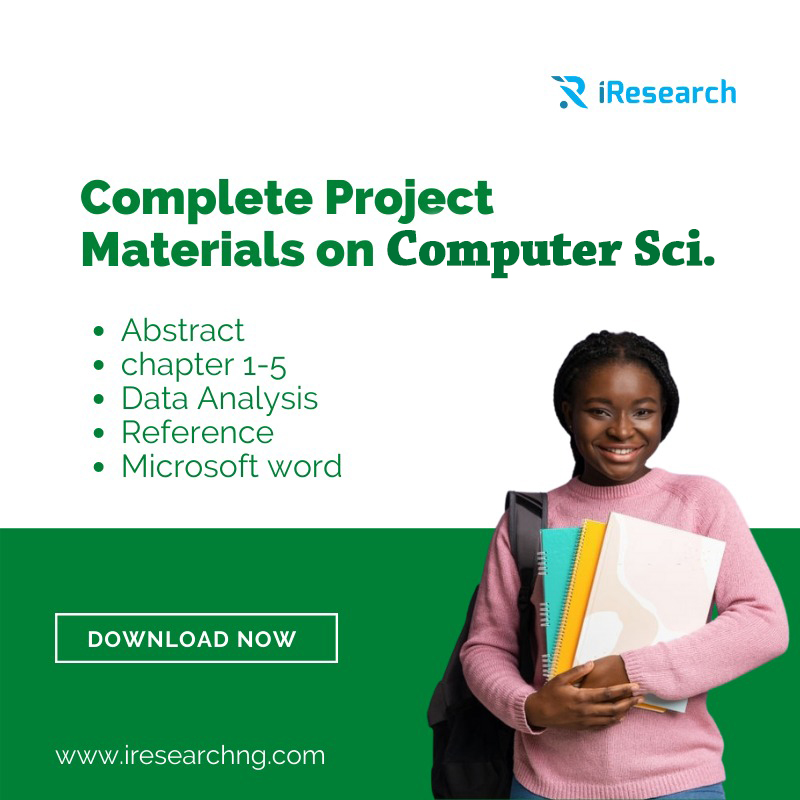



DESIGN AND IMPLEMENTATION OF MOBILE APPLICATION RESULT CHECKER
1.0 INTRODUCTION
Computers with the power of the internet have thrived in aiding communication among people.The telephone system, which is the main communication system that was invented several yearsago, had undergone a great improvement, so much that today we have fixed wireless phones, mobilephones and the likes. With the rapid development of mobile phones come several serviceslike the Short Messaging Service (SMS), Multimedia Messaging Service (MMS) and others,which are readily available and add to the usefulness of mobile phones.SMS in particular iswidely used in communication, andmore recently has been leveraged toprovide several services like airline ticketing,banking services, commercial serviceslike share and sell (an added serviceprovided by MTN Nigeria), wheresubscribers can easily share and/or sellairtime, and several others. SMS is amobile technology that allows for sendingand receiving text or even binarymessages to and from a mobile phone.The relative ease of use of SMS makes it possible for a user to learn how to send SMS easily.
Schofield and Kubin (2002) argued that small devices could potentially provide better interfacefor finding information than through page browsing and other means. More than 160 billion SMSare exchanged each month in European countries (Mavrakis, 2004), and according to ResourceShelf (2006), 48.7 billion SMS messages were sent in the second half of 2005, which is up 50%on the six months before that. Nowadays, with 45 million short messages sent in Africa aloneevery day, a mobile phone that has the easiest interface for voice communication is likely to failthe user satisfaction test if it does not provide a reasonably good SMS interface. (Gorienko&Merrick, 2003).
The major advantage of SMS is its cost effectiveness, and availability, as most individuals ownphone.In different parts of the world, several service providers offer mobile services which includeSMS. Most times the cost attached to sending a SMS is relatively small, and most providers donot charge when receiving SMS. Sometimes, service providers give users certain amount of freeSMS per month, which allows customers send and receive unlimited number of SMS messages. Itis possible to acquire a special dedicated line that uses a custom rate for messages sent to thenumber; it is also possible to have a number as toll free, making it free for users to send SMS tothe number. All these contribute to what makes SMS a really cost effective means of disseminatinginformation.
1.1 PROBLEM STATEMENT
Till today, especially in the developing countries, there still exists the problem of checking examinationresults as students still throng notice boards in anxiety. Although most universities,even those in the less developed countries now make examination results available on their websites.The level of internet availability in less developed countries is still low and quite expensive.Even in the developed countries where most homes have internet access, SMS is still a faster andcheaper means of dissemination examination results as well as other information. Pramsane andSanjaya (2006) stated that universities can provide educational services based on SMS such asgrade release, enrolment information, university announcement and internship opportunity. Anadvantage SMS offers is that students can receive valuable information on the fly without requestingfor it.
1.2 SIGNIFICANCE OF THE STUDY
The significance of this study includes the following:
· Convenience– Users get their results attheir own convenience.
· Accessibility – Users can access theirresults from any location (as long asthey are within a network service reception area).
· Portability– Results can be received and checked from any GSM phone. All GSMphones support SMS.
· Saves time– SMS is on the fly. It reduces the throughput of result checking as websitesare sometimes unavailable due to congestion, or server down time. SMS provides a fastermeans of sending and receiving such information.
· Cheaper – SMS is generally economical, and it sometimes provided as a free service (at least for certain periods) by the service provider. Most providers also do not charge whenusers receive SMS.
· Less human resources required– Results are processed automatically
· Mobility– It is obvious that most mobile phone users have their phones with them everywherethey go, most people often leave their computer as home, or work sometimes,but they will always have their phone on them.
1.3 Objective of the study
· To develop a Mobile Result Checker Application that will receive SMS from all kind of phones from all networks.
· The application will be able to notify users when they make an invalid request.
· The application should be able to provide security using password.
· The application will be relatively easy to customize.
1.4 Limitation of the study
The problems encountered during the course of carrying out this research work include:
· Fund: There was limited fund to take care of the research properly especially when test running the application.
· Research Material: Lack of access to research materials on the topic in the school library and even public libraries were also a major constraint in the cause of this project.
1.5 SCOPE OF THE STUDY
For the purpose of this research work, the researcher shall be limited to developing a mobile application result checker that will be us anIndependent Service;this involves using solely a mobile phone and the application server (thesystem running the SMS application). This option offers limited benefit, but it is easy and fast to setup. It does not require authorization of the service provider or connection to any third partySMS provider. The mobile phone uses a regular SIM card which has a normal phone number, andmessages that originate from the phone attracts the standard cost or tariff.
NOT THE TOPIC YOU ARE LOOKING FOR?
Once payment is made, kindly send us your project topic, email address and payment name to +234 810 144 4147
Once payment is confirmed, Project materials will be sent to your email